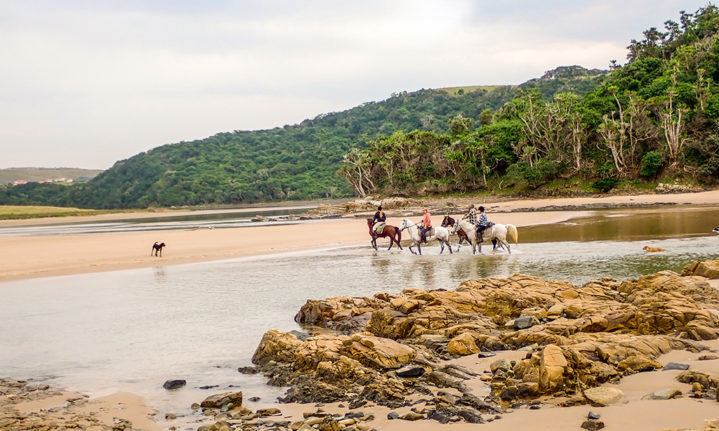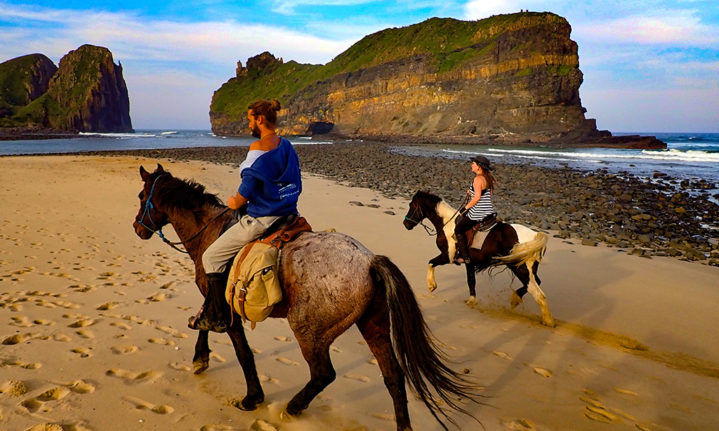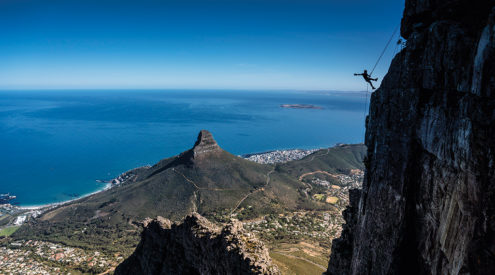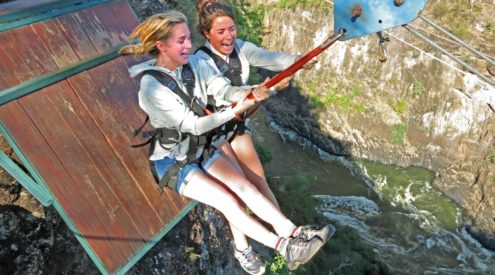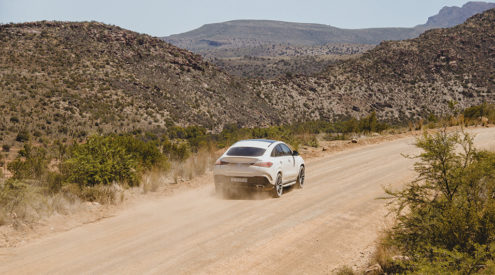Following the philosophy of ‘if a cow can go there so can we’, eight riders, 10 horses and four dogs traversed the rugged, unspoilt landscape of the Wild Coast for 24 days on a route-plotting ride from Kei Mouth to the Mtentu River.
Story by Trish Wheeler
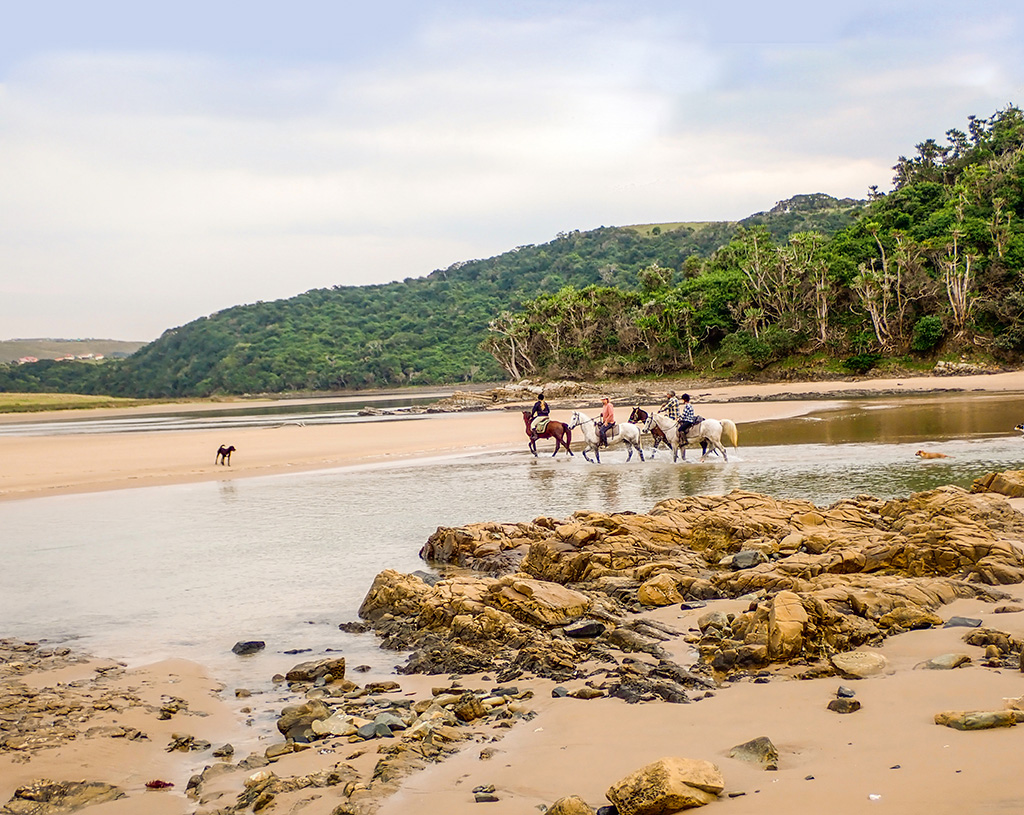
Another day, another river crossing – this is the Ntlonyane River in the Cwebe Nature Reserve. Much of the first leg of the journey traverses the twin reserves of Cwebe and Dwesa. Image credit: Sarah Barnett
For more than 20 years I’ve travelled the world, filling my global adventure jar with incredible experiences. But besides the Camino de Santiago walking pilgrimage in Spain, my journeys have all been fuelled by trains, planes and automobiles.
When my long-time friend, Shane Eades, shared his dream of leading horseback expeditions along the Wild Coast and invited me to join his pioneering group, I was excited but apprehensive. As an inexperienced rider, the prospect of spending more than three weeks in the saddle, crossing rivers, beaches, fairy forests and rocky river mouths was daunting.
Shane owns Terra-Khaya Eco-backpackers and Amathole Horse Trails in Hogsback and has been around horses all his life. Together with friend Sebastian Gidlow, also an experienced rider and ex-show-jumper, they nurtured the Wild Coast horsey dream to fruition.

Author Trish Wheeler on Tammy, Shane Eades on Django and Apache going solo, emerge from the Msikaba River after an exhilarating sunrise swim on the final day of the journey to Mtentu. Image credit: Henry Uys
Twelve riding lessons later, when I could canter comfortably without falling off, I – and my very minimal baggage – joined Shane, Seb, six of their mates, 10 horses and four dogs in Kei Mouth for the start of this epic journey. A support vehicle would meet us at various points along the way, but for the most part we had to carry everything we needed in custom-made saddlebags – from tents and clothing to medical supplies (horse and human), food and cooking utensils, divided up between us. Oh, and a mobile horse enclosure – an ingeniously simple contraption consisting of lightweight stakes and electric-fence wire powered by a battery.
From the moment we took off on the ferry crossing from Kei River Mouth, I knew this was going to be a special experience. I was captivated by the remoteness and pure wildness of the landscape. Beaches – up to three kilometres long – were interspersed with winding paths through emerald forests or cattle paths over seemingly endless green hills. We sampled local hospitality at some of the spazas and shebeens along the way. Nights were divided between sleeping out under a million stars or in one of the many backpackers along this beautiful coast.
Early in the journey, after a night of camping next to the Nqabara River Mouth, we woke to the echoes of ‘Kom-kom-kom’. This was Shane’s way of calling the horses when they’d escaped their holding pen, and became a regular part of everyone’s vocabulary. Fortunately our steeds never went far, and the great thing about herd mentality is: snag one or two and the rest will follow. There were several other Great Horse Escapes during the journey, most instigated by the big guy Django. Just like the lead in the Tarantino film, he has a restless spirit, and could break out of almost anywhere. When Django led the herd for a gander around the village of Mbotyi, a little schoolboy came to tell us, ‘There are 10 horses over the hill.’
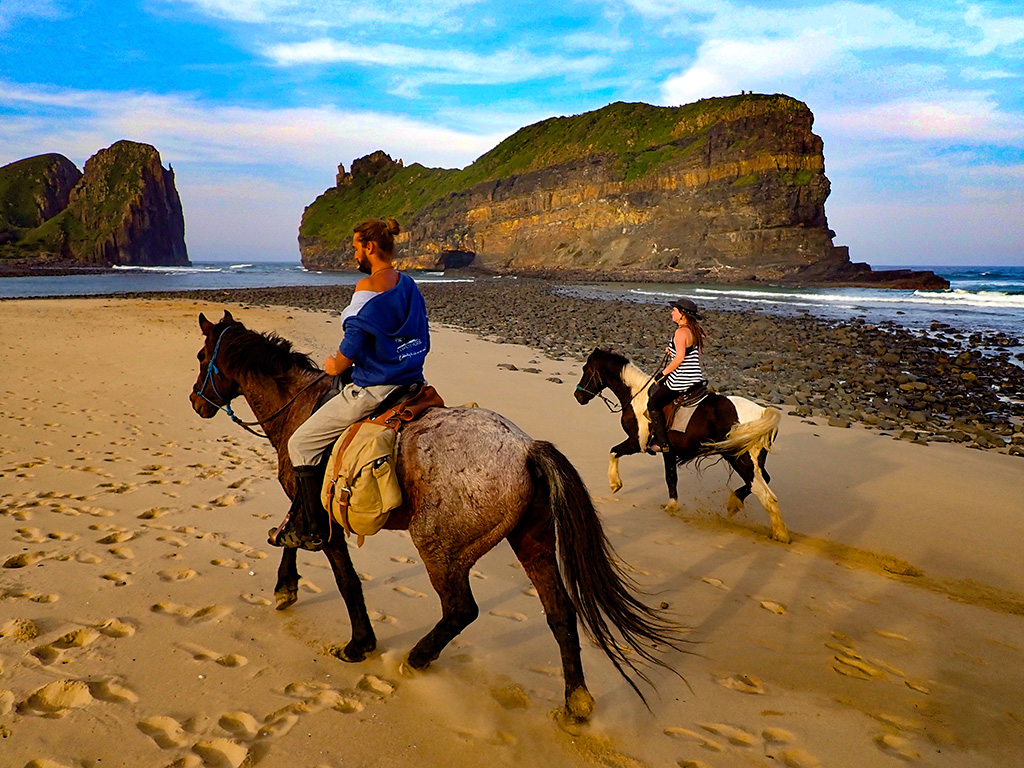
Janice Adlam on Apache and Gautier Amedro on Baloo approach Hole in the Wall, the amaXhosa’s ‘place of thunder’. Image credit: Trish Wheeler
While strolling through the sleepy village of Plaatjie, its little rondavels dotting the hills around us, we received curious looks from resident cows, donkeys and villagers. And we got a royal reception from the local school kids, astonished at the sight of this posse passing through their ‘hood – an unlikely band of mlungu cowboys.
Since we were the pioneers of this adventure, there were bound to be a few mishaps along the way as we negotiated wrong turns, impassable terrain, unclear paths and hills, all gentle and inviting from afar until we got to them.
On one such day a foiled attempt at crossing the Mbashe River got us lost in a huge forest, losing our reconnaissance crew, running down our cellphone batteries, and ending up back where we’d started that morning. Fortunately it was a gorgeous camping spot on a clifftop with the mouth of that elusive river beckoning in the distance.
Our general rule of thumb was that if a cow could get there so could we, but this sometimes meant hopping off our ponies and clambering up, down, under or over low branches and rock faces.

Following narrow contour paths on the steep grassy hills requires careful planning to choose the correct one. Image credit: Henry Uys
After a successful Mbashe River crossing, we rode to Breezy Point and set up camp in a field that rolled straight down to a long beach. Perfect for a midnight bareback gallop (for the more experienced riders). I’ll never forget the whoops of joy echoing back, and then their silhouettes against a full moon as they rode towards us – these magnificent men on their flying ‘machines’. ‘Next time that’s me,’ I said, ‘even if I have to be tied onto the horse!’
By now we were in a harmonious daily routine that involved coffee and meals, grooming and saddling the horses, taking down or setting up the horse enclosure and tents, collecting wood, building the evening fire and drying horse numnahs, socks and sometimes tobacco and toilet paper.
We’d also learnt some hard lessons – dry-bagging everything when we crossed a river; and the necessity of wearing shoes around the horses. The strength and power of these creatures is great for carrying a load and galloping down beaches, but you don’t want a hoof bearing some 450 kilograms coming down on your bare big toe – thanks to two comrades for taking one each for the team.

Shane Eades leads Shiva across clear pools near Waterfall Bluff. He is an advocate of ‘natural horsemanship’, so all the bridles are bitless which is more comfortable for the horse, and relies on developing a rapport with your steed. Image credit: Trish Wheeler
There was more wonder and delight as we meandered through the spectacular Hluleka Reserve, enveloped in a blizzard of white butterflies – as if we were in a wedding march and the heavens were raining confetti down on us.
Into the lingering colours of a sunrise, we rode from Mpande Beach to The Kraal Backpackers to meet Shane’s zany friend Dillon Harvey. His pizzas are so legendary you need to order them in the morning to eat in the evening. In lieu of pizzas he made us super-green juices with his homegrown veggies.
We entered the little village of Mqaleni and realised that we’d arrived a day early. By losing ourselves in the journey, we’d somehow gained a day. Since we were only due in Port St Johns two days later, it was a unanimous decision to take a 24-hour rest, and a more incredible place we could not have dreamt of for exploration – from mangrove swamps and forest trails, to a cave in a forested cliff covered with aloes and beautiful trees shaped by the wind.
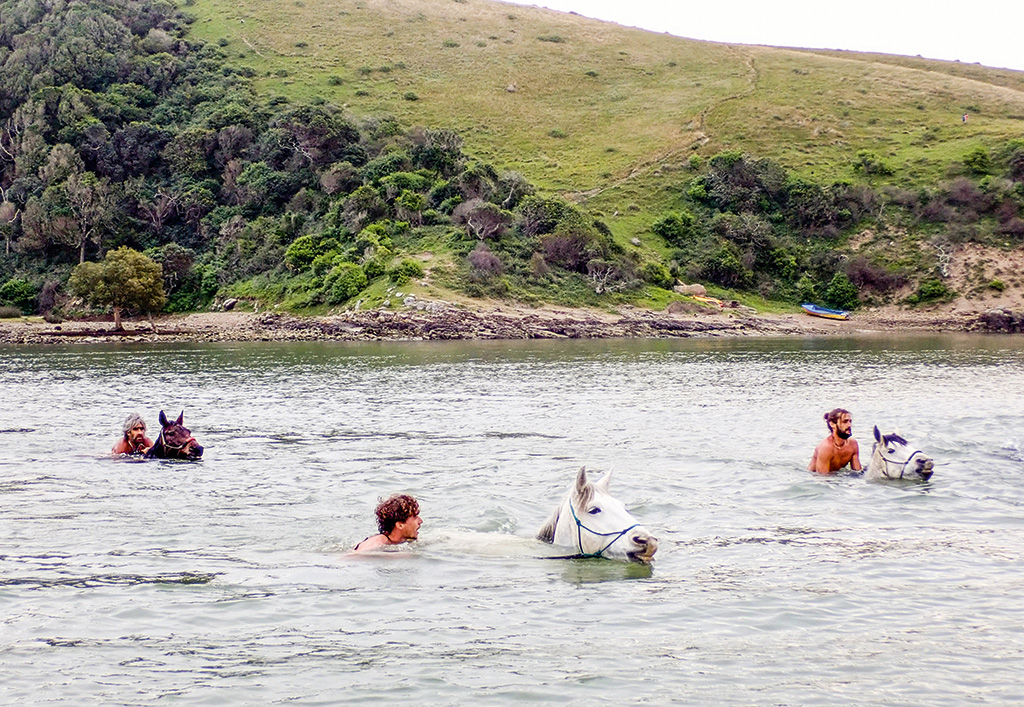
Mthatha River crossing. Image credit: Trish Wheeler
Around Day 17, after passing Sicambeni Village, we found ourselves on a steep descent on foot. One of my biggest lessons during the journey was learning to trust the horses. I garnered such respect for these animals and how they could negotiate the rocks on hooves with heavy saddlebags. This tricky section led us to a dramatic entry into Port St Johns, galloping through the parking lot at Second Beach to the cheers of picnicking locals as we thundered past – grungy riders and horses whooping and snorting – onto the main road and right up to the bar of AmaPondo Backpackers, where we downed our beers cowboy-style.
The area from Port St Johns to Mtentu was almost empty of people and days went by without us sighting another human being. Nights were spent under star-spangled skies. We passed the spectacular Cathedral Rock and explored the mystical Poenskop Cave. Just before Luputhana we stopped off at what might be the crowning glory of the whole Wild Coast, Waterfall Bluff, where a 70-metre waterfall plunges directly into the ocean.
Day 23 and the (literal) one-horse town of Mkweni fast became a 11-horse town while we scoured for supplies. Having found a decrepit spaza shop that stocked only Castle beer and Lucky Star pilchards, we plodded empty-handed down the road where we encountered a sweet little mare whose eyes lit up at the sight of our handsome ‘boys’ striding by. Thankfully for me they were playing hard to get, since I was riding Shiva, the young stallion and the herd’s homecoming king.
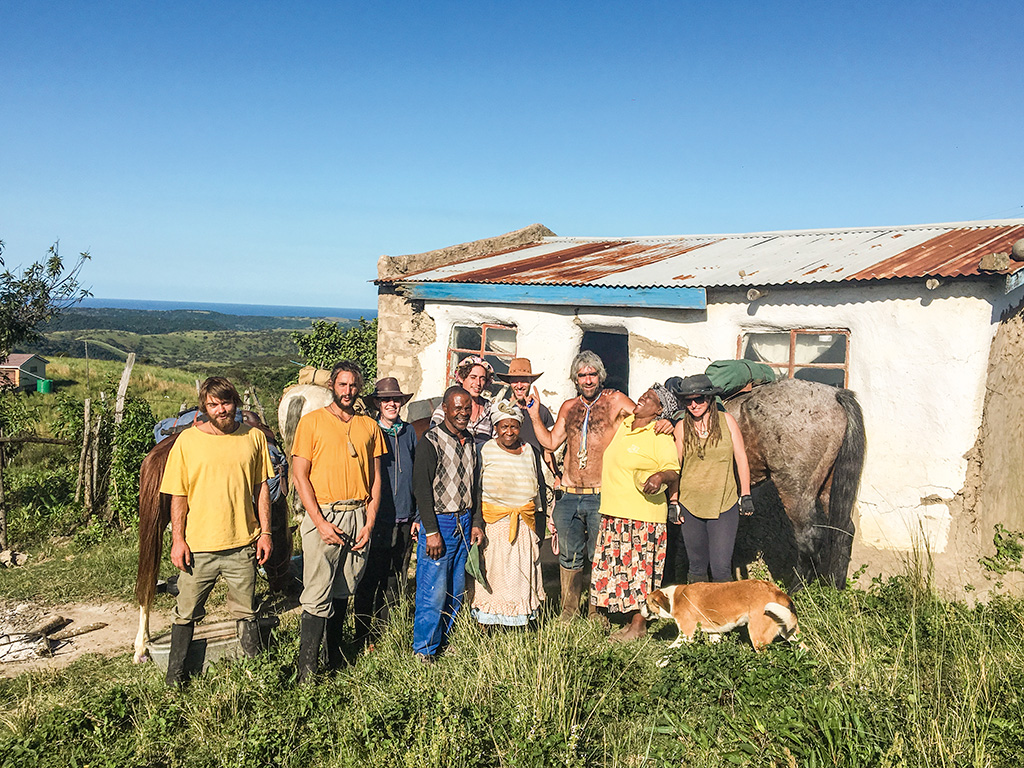
Plaatjie village. Image credit: Trish Wheeler
Somewhere near Port Grosvenor, we had the only scary moment of the whole trip. While I was navigating some rocks down onto a beach, Shiva’s hoof slipped into a crack and his foreleg got stuck. It was a gut-wrenching few minutes while Shane and Seb calmed him and skilfully got him to kneel down so they could manoeuvre his leg out of the crack. The prospect of a broken leg on one of the horses was terrifying.
Our penultimate day was our only rainy one, drenching us from head to hooves. In the driving torrent, we landed up in a boggy marshland, and with looming dark making it tricky to negotiate our way any further, we squatted in some deserted holiday houses. The rain was a relentless, all-night affair, plus we had to be up at 3.30am the next morning to cross the Msikaba River at low tide.
A successful crossing brought us to the Mkambathi Nature Reserve with its expanses of open grassy plains. Wildlife was not abundant, save for a few zebra, but we had panoramic views of the ocean, and everywhere you looked were whales and dolphins breaching. It was the middle of the sardine run, so the action in and around the ocean was quite a spectacle.
Beyond the Mtentu River lay our final destination. On Google Earth the mouth is a big sand bar with a narrow channel but recent floods had swept the sand away and what confronted us was 200 metres of deep blue, choppy water with big swells rolling in from the ocean. We loaded the saddles and saddlebags into ferry canoes. Then it was just the horses, the dogs, the river and us – a tribe huddle in the ocean, hearts pounding, horses snorting, dogs paddling while waves crashed onto us. But the bond we’d developed with the horses and each other by then was phenomenal and it carried us safely across the river and up the hill on the other side – a fitting end to the inspiring, fun, physically and emotionally challenging, crazy journey that had started 24 days and 350 kilometres before.

Plan Your Trip
Getting There
East London and Mthatha are the closest major hubs (and the nearest airports), from where you need to get to Kei Mouth, Mdumbi Backpackers (on a rugged dirt road) or Port St Johns. Vehicle access to the start or end of the various rides (see box opposite) is challenging, so Terra-Khaya runs a shuttle from these three places to either the start, or back to your vehicle at the end of each ride.
Need To Know
These rides are not for beginners and there is plenty of fast-paced riding and long days in the saddle. The support vehicle meets up with riders at the end of most days, except for the Pondoland stretch which is too remote and inaccessible.
The rides take place in winter when the weather is mild here, with warm days and mostly balmy nights, but it can get chilly, and expect some rain. Be prepared for deep-water river crossings and some on-foot hiking.
Each ride package includes all meals and accommodation (not beverages); all camping equipment; riding helmets and gaiters/chaps; saddle-bags and dry bags for your clothing; insurance; first-aid and medical supplies, and a ride hoodie.
Contact
Terra-Khaya (Shane Eades) 076-437-1898, terrakhaya.co.za
This article was first published in the March 2020 issue of Getaway magazine.
Get this issue →
All prices correct at publication, but are subject to change at each establishment’s discretion. Please check with them before booking or buying.










